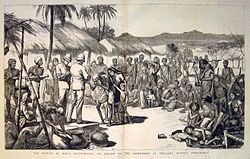Slavery in Madras Presidency
| Colonial India | ||||||||||||||
|---|---|---|---|---|---|---|---|---|---|---|---|---|---|---|
 | ||||||||||||||
|
||||||||||||||
|
||||||||||||||
|
||||||||||||||
Slavery in the Madras Presidency during the
The patterns of slavery and slave population varied between districts. Various laws were passed during 1811, 1812 and 1823 to restrict slavery and prevent child labour, though the slave trade was only ended with the Indian Slavery Act of 1843, and the sale of slaves became a criminal offence in 1862 under the new Indian Penal Code.
The presidency

Pattern

The Mirasdars, or landlords, were usually from the higher castes. Lower caste individuals borrowed money
Francis Whyte Ellis observed that all the Paraiyars who resided in the areas where Mirasi rights reigned resided in a form of enslavement which he named 'villeinage'. The Paraiyans were at the bottom of the caste hierarchy, they were untouchables and kept in isolated areas outside the community at the So-called paraicheri. For the labour they completed, they were entitled to a variety of payments in grain and money. They were also compensated for the services they provided the town in a variety of lower positions, such as scavengers, watchmen, and messengers.[6] Ellis listed three slave castes: the Palli, the Pallan, and the Paraiyan. While the Pallars and Paraiyars worked for the Vellalars, the Pallis who were Shudras but weren't untouchables, typically served the Brahmin Mirasidars.[7] Wallace, the collector of Tanjore, wrote in 1805 that out of the entire population of Mirasidars, 17,149 were Brahmins, 43,442 were Shudras, encompassing different Hindu castes and native Christians, and 1,457 were Muslims.[8]
The pattern of slavery varied between different districts of the presidency, as did the
Distribution

The Law Commission report on slavery in 1841 contained the indicative figures on the number of slaves, based the numbers categorised as
The
See also
Notes
- ^ Sohail, Sara (10 May 2019). "The Etymology of Madras". Madras Courier. Madras Courier.
- ^ Frykenberg, Robert Eric (1968). Elite Formation in Nineteenth Century South India, Proceedings of the First International Conference on Tamil Culture and History. Kuala Lumpur: University of Malaysia Press.
- ^ British and Foreign Anti-slavery Society 1841, p. 5
- ISBN 9781846317583.
- ^ Hjejle 1967, pp. 78.
- ^ Hjejle 1967, pp. 79.
- ^ Hjejle 1967, pp. 80.
- ^ Hjejle 1967, pp. 84.
- ^ Kumar pp. 43–48
- ^ British and Foreign Anti-slavery Society 1841, p. 4
- ^ Kumar pp. 52–53
- ^ British and Foreign Anti-slavery Society 1841, p. 27
- ^ "3&4 Will. IV, cap. 73". www.pdavis.nl. Retrieved 29 June 2017.
- ISBN 0-253-34810-2.
Bibliography
- British and Foreign Anti-slavery Society (1841). Slavery and the slave trade in British India: with notices of the existence of these evils in the islands of Ceylon, Malacca, and Penang, drawn from official documents. T. Ward, and to be had at the office of the British and Foreign Anti-Slavery society.
- Dharma, Kumar (1965). Land and Caste in South India: Agricultural Labor in the Madras Presidency During the Nineteenth Century. CUP Archive.
- Hjejle, Benedicte (1 January 1967). "Slavery and agricultural bondage in South India in the nineteenth century". Scandinavian Economic History Review. 15 (1–2). ISSN 0358-5522.
